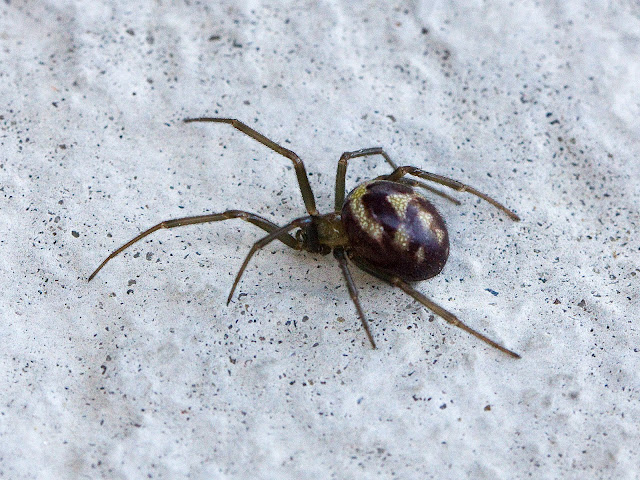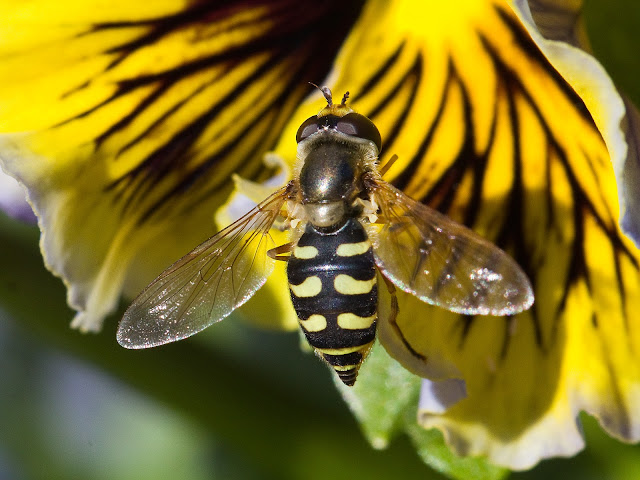With the onset of warmer days the insect life in the garden has slowly picked up and my searches have started to reveal some interesting subjects. They may not be the birds that I would normally be looking for but at least I have some interesting subjects to photograph.
Actually taking the photograph is relatively easy. Putting a name to the subject is the difficult part and I have spent many an interesting hour searching the web and reference books to confirm identities.
As with all my insect pictures, there is a health warning. I am not an expert, I will make mistakes from time to time, so treat my labelling with a degree of suspicion, and let me know if you find any mistakes.
First up is a Spider, Steatoda grossa commonly known as the Cupboard Spider and one of the group of False Widow spiders that the tabloids like to make so much fuss about. An easy one to identify, it has clear markings of a crescent followed by three or four chevrons down its abdomen. The markings are clearer on the male.
 |
| Steatoda grossa |
 |
| Steatoda grossa |
Does it bite, yes, but it's not aggressive. I haven't had the opportunity to try it, but like its close relation, the Noble False Widow Steatoda nobilis, the spiders bite can sometimes be painful. It is said to be something like a bee or wasp sting.The venom of spiders in the Steatoda group can also cause steatodism. This presents as a set of symptoms, most notably pain radiating from the bite, fever, nausea, headache, malaise, lethargy and even chest pains. Such severe reactions are apparently very rare and there has never been a fatality in the UK from a false widow spider bite.
The venom delivered by the genus Steatoda is a neurotoxin that attacks the nervous system not a necrotic venom that attacks the flesh. Pictures that you see in the tabloids of puss filled arms and legs having to be amputated, if genuine, would have to be the result of some secondary infection. Like any cut or bite, clean it properly and you should be OK.
I found the spider on the underside of the garden table as I carried it out of the garage. There are still a few spiders nests under there, so I am pleased I did the research. I will at least be able to explain what they are if they suddenly appear crawling across the table whilst we are in the middle of eating the barbecue.
I have not been able to identify the spider pictured below. It doesn't seem to have any markings on the abdomen. It may be a female Steatoda grossa which I have read can be found without any markings but it was a lot bigger than the male above.
 |
| Possibly a female Steatoda grossa |
Next up is a Wasp, this one the German Wasp - Vespula germanica. Whilst referred to as German it is native to the UK and Europe and has spread across most of the world where it is often seen as a pest threatening crops, native flora and fauna, and peoples life styles.
It being the spring I assume the wasp shown in this picture is a Queen. She would have overwintered in hibernation and emerged towards the end of spring. She already carries sperm impregnated last autumn and will search out a nest site and establish a new colony with workers emerging around June/July time.
 |
| German Wasp - Vespula germanica |
Looking very much like a wasp the next one is a Solitary Bee, a Gooden's Nomad Bee - Nomada goodeniana. The black on the back of some of the antenna segments identifies this one as a male. It is one of the largest and most common of the Nomad bees in the UK and like all Nomads it is a cleptoparasite. It targets a number of mining bees laying eggs inside their unsealed, pollen-stocked, nest cells. A cuckoo of the bee world.
 |
| Gooden's Nomad Bee - Nomada goodeniana |
Hoverflies - the first is Epistrophe eligans. It is a spring hoverfly widespread and common in the south of England. It does also occur in Northern England and around the coast in Scotland but in much smaller numbers.
 |
| Hoverfly - Epistrophe eligans |
Next up two examples of Myathropa florea. Another one that is easy to identify. It has a distinctive "Batman" marking on its thorax, which is not that distinctive in either of these pictures due to reflected light. It also has an unusual wing vein pattern.
 |
| Hoverfly - Myathropa florea |
 |
| Hoverfly - Myathropa florea |
 |
| Veins reach wing margin separately - diagnostic |
The next one is not so easy. It is of the tribe Syrphini probably of the genus Syrphus but this can only be confirmed using a microscope. Even if you get that far there are five different hoverflies in the genus, three of which are widespread and common.
 |
| Syrphus sp |
And another hoverfly that I cannot identify. This one I can narrow down to the genus Eupeodes. There are nine UK species of which three are common. The guides quote them as being very challenging to identify so there is no point in me going further other than to say on balance of location and flight time I would guess Eupiodes luniger. I should have taken a side view, it may have helped with the identification.
Nice find though, I now have my own pair of biological control agents. I just hope they are hungry.
 |
| Two Spot Ladybird Adalia bipunctata |
Harlequin Ladybirds worry me. They are an invasive species and they are here to stay. They are a good way of controlling aphids but they also prey on other insects and on their eggs and larvae including those of other ladybirds. You might expect that over time they would reach some form equilibrium with the existing UK species but it seems to me that most ladybirds that I see now are the various forms of Harlequins.
 |
| Harlequin Ladybird Harmonia axyridis |
The most common fly in the garden, a Green Bottle Fly, this one I think is Lucia sericata based on the presence of a pale basicosta - don't worry, I had to look it up as well.
 |
| Green Bottle Fly - Lucilia sericata |
There is still not the variety of insects in the garden that I had expected but it is improving as the weather warms up. If this continues for much longer I could end up with a decent garden list.

No comments:
Post a Comment